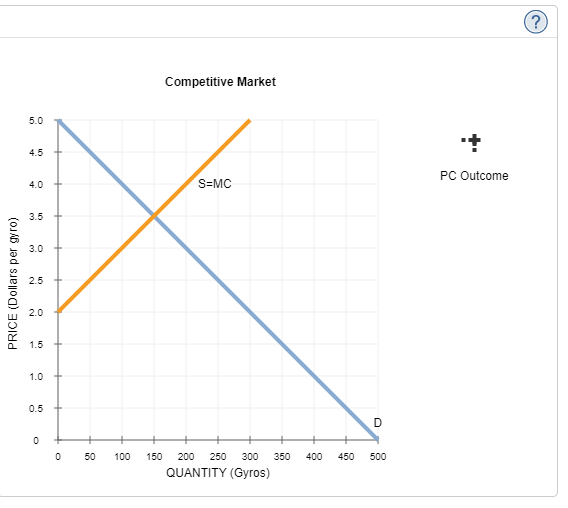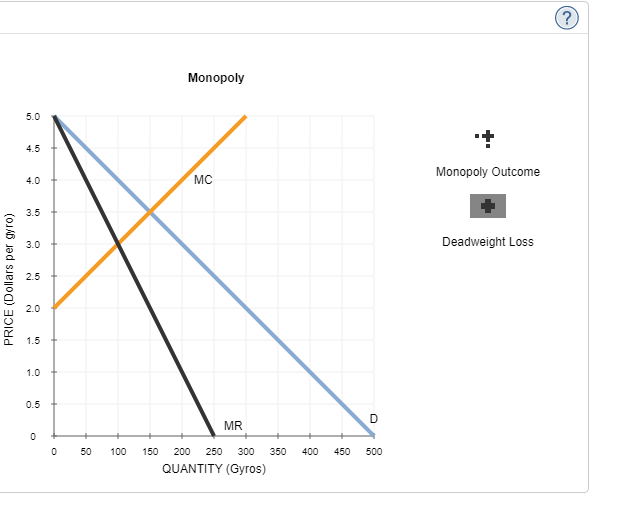Consider the weekly market for gyros in a popular neighborhood close to campus. Suppose this market is operating in long-run competitive equilibrium with many gyro vendors in the neighborhood, each offering basically the same gyros. Due to the structure of the market, the vendors act as price takers and each individual vendor has no market power. The following graph displays the supply (S = MC) and demand (D) curves in the weekly market for gyros. Consider the welfare effects that
Consider the weekly market for gyros in a popular neighborhood close to campus. Suppose this market is operating in long-run competitive equilibrium with many gyro vendors in the neighborhood, each offering basically the same gyros. Due to the structure of the market, the vendors act as price takers and each individual vendor has no market power. The following graph displays the supply (S = MC) and demand (D) curves in the weekly market for gyros. Consider the welfare effects that
Managerial Economics: A Problem Solving Approach
5th Edition
ISBN:9781337106665
Author:Luke M. Froeb, Brian T. McCann, Michael R. Ward, Mike Shor
Publisher:Luke M. Froeb, Brian T. McCann, Michael R. Ward, Mike Shor
Chapter20: The Problem Of Adverse Selection Moral Hazard
Section: Chapter Questions
Problem 3MC
Related questions
Question
Consider the weekly market for gyros in a popular neighborhood close to campus. Suppose this market is operating in long-run competitive equilibrium with many gyro vendors in the neighborhood, each offering basically the same gyros. Due to the structure of the market, the vendors act as price takers and each individual vendor has no market power.
The following graph displays the supply (S = MC) and demand (D) curves in the weekly market for gyros.
Consider the welfare effects that result from the industry operating as a competitive market versus a monopoly .
On the monopoly graph, use the black points (plus symbol) to shade the area that represents the loss of welfare, or deadweight loss , caused by a monopoly. That is, show the area that was formerly part of total surplus and now does not accrue to anybody.
Deadweight loss occurs when a market is controlled by a monopoly because the resulting equilibrium is different from the (efficient) competitive outcome.
In the following table, enter the price and quantity that would arise in a competitive market; then enter the profit-maximizing price and quantity that would be chosen if a monopolist controlled this market.
|
Market Structure
|
Price
|
Quantity
|
|---|---|---|
|
(Dollars)
|
(Gyros)
|
|
| Competitive |
|
|
| Monopoly |
|
|
Given the summary table of the two different market structures, you can infer that, in general, the price is higher under a (monopoly or competitive market), and the quantity is higher under a (competitive market or monopoly) .

Transcribed Image Text:PRICE (Dollars per gyro)
5.0
4.5
4.0
3.5
3.0
2.5
2.0
1.5
1.0
0.5
0
0
50
Competitive Market
S=MC
100 150 200 250 300 350 400
QUANTITY (Gyros)
D
450 500
**
PC Outcome
(?

Transcribed Image Text:4.5
4.0
MC
3.5
3.0
K
2.5
2.0
1.5
1.0
MR
PRICE (Dollars per gyro)
5.0
0.5
0
Monopoly
0
50 100 150 200
D
250 300 350 400 450 500
QUANTITY (Gyros)
Monopoly Outcome
Deadweight Loss
(?)
Expert Solution
This question has been solved!
Explore an expertly crafted, step-by-step solution for a thorough understanding of key concepts.
This is a popular solution!
Trending now
This is a popular solution!
Step by step
Solved in 5 steps with 4 images

Knowledge Booster
Learn more about
Need a deep-dive on the concept behind this application? Look no further. Learn more about this topic, economics and related others by exploring similar questions and additional content below.Recommended textbooks for you

Managerial Economics: A Problem Solving Approach
Economics
ISBN:
9781337106665
Author:
Luke M. Froeb, Brian T. McCann, Michael R. Ward, Mike Shor
Publisher:
Cengage Learning

Managerial Economics: A Problem Solving Approach
Economics
ISBN:
9781337106665
Author:
Luke M. Froeb, Brian T. McCann, Michael R. Ward, Mike Shor
Publisher:
Cengage Learning